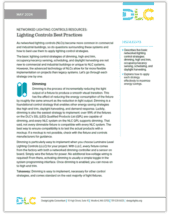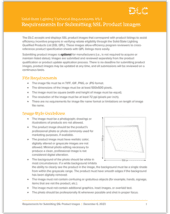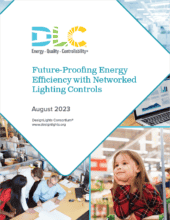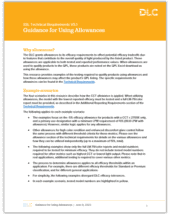This website uses cookies so that we can provide you with the best user experience possible. Cookie information is stored in your browser and performs functions such as recognising you when you return to our website and helping our team to understand which sections of the website you find most interesting and useful.
Industry Reports, Research, & DLC Resources
Use the category filter to the right to find the specific resources.

Executive Summary: Choosing Both Energy Efficiency and Light Pollution Mitigation for Commercial Outdoor Lighting
There is a perception that, in a commercial retrofit setting, light pollution mitigating LEDs are less efficient and more costly than energy efficient LEDs, but in some cases you can have the best of both worlds. The DLC commissioned a study to research the impacts of LED applications that are both energy efficient and minimize light pollution as compared with products focused solely on energy efficiency. This executive summary provides an overview of the results of the research.
Key Takeaways
- An overview of how utilities can help municipalities achieve their energy efficiency and decarbonization targets while protecting ecosystems and preserving the night sky for future generations.

Choosing Both Energy Efficiency and Light Pollution Mitigation for Commercial Outdoor Lighting
There is a perception that, in a commercial retrofit setting, light pollution mitigating LEDs are less efficient and more costly than energy efficient LEDs, but in some cases you can have the best of both worlds. The DLC commissioned a study to research the impacts of LED applications that are both energy efficient and minimize light pollution as compared with products focused solely on energy efficiency. The study includes analysis of the impact on ROI, annual energy use, and energy costs.
Key Takeaways
- Learn how utilities can help municipalities achieve their energy efficiency and decarbonization targets while protecting ecosystems and preserving the night sky for future generations.
- Discover how municipalities can meet their energy goals while reducing the harm caused by excessive outdoor lighting.
- Learn new ways to calculate ROI for responsible outdoor lighting.

Lighting Controls Best Practices
This resource explains the following basic networked lighting control strategies: dimming, high end trim, occupancy/vacancy sensing, scheduling, and daylight harvesting, and gives an overview of how to implement them to maximize energy savings.
Key Takeaways
- Describes five basic networked lighting control strategies: dimming, high end trim, occupancy/vacancy sensing, scheduling, and daylight harvesting.
- Explains how to apply each strategy effectively to maximize energy savings.

Requirements for Submitting SSL Product Images
The DLC accepts and displays product images on the Solid-State Lighting QPL (SSL QPL) to allow energy efficiency program staff to cross-reference product specification sheets with QPL listings more easily. Image submission is not required for qualification. This resource details the DLC's requirements and style guidelines for SSL product images.
In this Resource
- Requirements and guidelines for formatting and submitting product images to display on the SSL QPL.

Future-Proofing Energy Efficiency with Networked Lighting Controls
This is a summary of the potential study commissioned by the DLC titled "Economic Potential of Networked Lighting Controls in Commercial Buildings: Tapping the Added Value of HVAC Connections."
Key Takeaways
- Learn how integrating HVAC and NLC systems can enhance energy efficiency, increase ratepayer savings, and lower carbon emissions.
- Action items for regulators and energy efficiency programs based on the new data.

Guidance for Using Allowances
This resource provides examples of the testing required to qualify products to the SSL QPL using efficacy allowances, and explains how those allowances may affect the product’s QPL listing.
Key Takeaways
- Provides four example scenarios for using efficacy allowances when qualifying products to the SSL QPL.
Still need help?
© 2023 DesignLights Consortium. The DesignLights Consortium is a project of Efficiency Forward, Inc., a non-profit 501(c)3 organization. Privacy Policy Terms of Use


